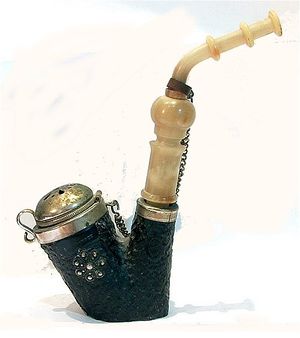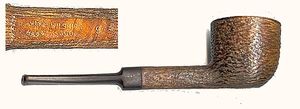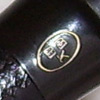Bru-Bu: Difference between revisions
No edit summary |
No edit summary |
||
| Line 1: | Line 1: | ||
'''Josef Brunner''', oldest son of the farmer Konstantin Brunner from the hamlet Nieder-Huggerwald belonging to the community of Kleinlützel (Canton Solothurn), was sent in 1871 to a pipe turner in Winkel / Alsace for his apprenticeship. Like it was usual at that time, Brunner went on wanderings as travelling journeyman after ending the apprenticeship. So he came to Saint-Claude, the world's stronghold of the briar pipe manufacturing then. There Brunner was able to increase and deepen his knowledge in the field of industrial pipe making. | |||
Back home in 1878, he installed a small turner's workshop in the house of his father. With the energetic support of his two younger brothers, he began to produce tobacco pipes on own calculation and to bring them to the markets in the surrounding. In 1893 Bernhard Brunner's wife inherited the mill in Kleinlützel. Thereupon the pipe fabrication was transferred to an annex belonging to the mill. Now it was possible to drive the machines by water power - an important relief to the workers and a cosiderable progress comparing the previous drive by pedals! | |||
[[Image:BBK_9.jpg|right|thumb|Swiss style Bru-Bu]] | |||
The production could be boosted and business developed pleasantly. A new factory building could be edified by 1896. Corresponding to another demand a department producing walking sticks factory was added in 1900. The pipes from Kleinlützel were well appreciated and received many awards e.g. a gold medal for outstanding craftsmanship at the National Swiss Fair in Bern in 1914. | |||
The business developed so well after the turn of the century, that even a lack of workers in Kleinlützel occured. The problem was solved by founding a subsidiary company in the small nearby town Laufen an der Birs in the Canton of Bern. This plant didn't exist too long. The disastrous economical crisis in the 1920's and early 1930's forced the Brunner family to restrict the fabrication of pipes dramatically. In addition the big French pipe factories in Saint-Claude - although suffering from the same circumstances - flooded the Swiss market with pipes at prices that couldn't be machted by Swiss producers. By 1931 ca. 150 of 180 Brunner employees had been sacked - the rest remained in Kleinlützel, where the cheap electric energy ensured a meager survival. | |||
In 1932 a Mr. '''Buhofer''' joined the Brunner family. The company was named Brunner-Buhofer-Kompagnie, shortly Bru-Bu. Buhofer had made his pile in the United States but fell so homesick that he returned to Switzerland and searched for a new challenge now. | |||
[[Image:Wilshire1.jpg|left|thumb|Wilshire - Bru-Bu made, ca. 1950's]] | |||
Bru-Bu's fabrication program was expanded with many handcrafted wooden art articles. Carved family coats of arms, bread plates, fruit scarves and - more and more - souvenir articles for the expanding Swiss tourism industry. Pipes remained in the programm continously, but the offer fluently changed from traditional Swiss pipes to more "European standard" shapes. | |||
At some point in the late 1970's Bru-Bu went out of business. Some of the Brunners, as far as known, continued as timber traders. But in 1986 new life filled the old Bru-Bu pipe workshop, when the gang of '''Dr. Horst Wiethüchter''' and '''"Former" Nielsen''' started to produce the high-grade '''[[Bentley]]''' pipes there. (The article on Bentley is coming soon.) | |||
[[Image:Bbk1a.jpg]] BBK logo | [[Image:Bbk1a.jpg]] BBK logo | ||
Following Josef Brunner, '''Moritz Tschan''' in 1892 established a second pipe factory in Kleinlützel. Wherewith the small place in the Canton of Solothurn became the center of the Swiss pipe manufacturing - rhapsodically called "the Saint-Claude of Switzerland". | |||
[[Category: Pipe makers by nationality]][[Category: Switzerland]] | [[Category: Pipe makers by nationality]][[Category: Switzerland]] | ||
Revision as of 20:29, 22 July 2008
Josef Brunner, oldest son of the farmer Konstantin Brunner from the hamlet Nieder-Huggerwald belonging to the community of Kleinlützel (Canton Solothurn), was sent in 1871 to a pipe turner in Winkel / Alsace for his apprenticeship. Like it was usual at that time, Brunner went on wanderings as travelling journeyman after ending the apprenticeship. So he came to Saint-Claude, the world's stronghold of the briar pipe manufacturing then. There Brunner was able to increase and deepen his knowledge in the field of industrial pipe making.
Back home in 1878, he installed a small turner's workshop in the house of his father. With the energetic support of his two younger brothers, he began to produce tobacco pipes on own calculation and to bring them to the markets in the surrounding. In 1893 Bernhard Brunner's wife inherited the mill in Kleinlützel. Thereupon the pipe fabrication was transferred to an annex belonging to the mill. Now it was possible to drive the machines by water power - an important relief to the workers and a cosiderable progress comparing the previous drive by pedals!
The production could be boosted and business developed pleasantly. A new factory building could be edified by 1896. Corresponding to another demand a department producing walking sticks factory was added in 1900. The pipes from Kleinlützel were well appreciated and received many awards e.g. a gold medal for outstanding craftsmanship at the National Swiss Fair in Bern in 1914.
The business developed so well after the turn of the century, that even a lack of workers in Kleinlützel occured. The problem was solved by founding a subsidiary company in the small nearby town Laufen an der Birs in the Canton of Bern. This plant didn't exist too long. The disastrous economical crisis in the 1920's and early 1930's forced the Brunner family to restrict the fabrication of pipes dramatically. In addition the big French pipe factories in Saint-Claude - although suffering from the same circumstances - flooded the Swiss market with pipes at prices that couldn't be machted by Swiss producers. By 1931 ca. 150 of 180 Brunner employees had been sacked - the rest remained in Kleinlützel, where the cheap electric energy ensured a meager survival.
In 1932 a Mr. Buhofer joined the Brunner family. The company was named Brunner-Buhofer-Kompagnie, shortly Bru-Bu. Buhofer had made his pile in the United States but fell so homesick that he returned to Switzerland and searched for a new challenge now.
Bru-Bu's fabrication program was expanded with many handcrafted wooden art articles. Carved family coats of arms, bread plates, fruit scarves and - more and more - souvenir articles for the expanding Swiss tourism industry. Pipes remained in the programm continously, but the offer fluently changed from traditional Swiss pipes to more "European standard" shapes.
At some point in the late 1970's Bru-Bu went out of business. Some of the Brunners, as far as known, continued as timber traders. But in 1986 new life filled the old Bru-Bu pipe workshop, when the gang of Dr. Horst Wiethüchter and "Former" Nielsen started to produce the high-grade Bentley pipes there. (The article on Bentley is coming soon.)
Following Josef Brunner, Moritz Tschan in 1892 established a second pipe factory in Kleinlützel. Wherewith the small place in the Canton of Solothurn became the center of the Swiss pipe manufacturing - rhapsodically called "the Saint-Claude of Switzerland".


